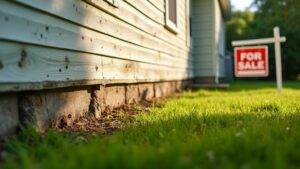Water damage can quietly ruin your home sale or inspection. Many sellers miss the signs until it is too late. Hidden leaks and moisture can lower your home’s value and scare away buyers.
This problem grows worse if you ignore it. Left unchecked, water damage leads to mold, wood rot, and costly repairs. Buyers and inspectors will spot these issues and use them to negotiate a lower price. Water damage can make or break your home sale, so you must learn to detect and address it early.
You can protect your investment by understanding the signs and fixing problems fast. Knowing what to look for gives you an advantage in any deal. This blog will help you spot water damage, avoid inspection surprises, and keep your home’s value strong.
Key Takeaways
- Water damage is a red flag during home inspections, often leading to failed sales or demands for costly repairs.
- Inspectors use tools like moisture meters and infrared cameras to detect hidden leaks and assess structural risks.
- Water damage can weaken foundations, walls, and floors, reducing home value and threatening structural safety.
- Mold growth from water intrusion poses health risks and requires full disclosure, affecting buyer trust and legal compliance.
- Unrepaired water issues complicate negotiations, lower selling prices, and may lengthen a home’s time on the market.
Common Signs of Water Damage in Homes

Water damage in homes is often easy to spot if you know the signs. Discoloration on walls or ceilings can mean water is leaking. Musty smells, warped floors, or bubbling paint are also common warning signs.
Small stains may point to slow leaks, which waste water and raise your bills. Corroded pipes or loose fittings can signal plumbing problems. Moisture under sinks or high humidity in rooms like bathrooms may show hidden leaks. In Shenandoah, houses in any condition—including those with water damage—can be sold quickly without the need for repairs.
Efflorescence on brick or concrete might mean water is seeping through. If you hear constant dripping, you should check for leaks. Early repairs help protect your house and save water.
If the water damage leads to further issues like disclosure requirements, you may face legal or sales complications if they aren’t addressed before selling your home.
How Inspectors Identify Water Issues
Inspectors find water issues by using a clear step-by-step process. They look for signs of leaks, damage, or moisture problems. Their goal is to protect the home and save water.
Inspectors check plumbing for leaks, rust, and old parts. If pipes are damaged, they may suggest repairs to prevent hidden water loss. They also look for signs that water is not being cleaned properly. Inspectors report their findings in detailed closing documents to help buyers and sellers address issues promptly.
They examine the outside of the house to see if water flows away from the foundation. Good drainage helps keep water out and supports water-saving efforts. If the ground slopes toward the house, inspectors may recommend changes.
Inspectors look at ventilation in attics and crawl spaces. If air does not move well, mold and water damage can appear. They may suggest better airflow to control humidity.
A careful inspection helps keep your home safe and saves water. If any problem is found, the inspector will explain what to fix. This process supports your home’s strength and your water-saving plans.
Inspectors understand that curb appeal can be affected by visible water damage, so they may advise addressing any stained walls or damaged exterior surfaces before listing a home for sale.
The Role of Moisture Meters and Infrared Cameras

Moisture meters and infrared cameras help inspectors find hidden water problems. Visual checks alone may miss moisture inside walls or under floors. These tools provide deeper, more accurate results.
Using this technology is similar to how professionals define spaces with rugs or furniture to clearly show a room’s purpose—each tool makes invisible issues or features more obvious to buyers and sellers. Moisture meters and infrared cameras reveal hidden water issues that visual inspections might miss, offering more thorough and accurate results.
A moisture meter measures the amount of moisture in building materials. It shows if there is dampness that cannot be seen. If readings are high, inspectors know where to look closer.
An infrared camera detects temperature differences on surfaces. This camera spots cold areas that may mean leaks or wet insulation. If there are unusual patterns, inspectors can investigate further.
If both tools are used together, inspectors can confirm findings from one tool with the other. This approach helps catch both obvious and hidden moisture issues. Accurate inspections lower the risk of missed problems. Early discovery of hidden leaks and damage is crucial to protect property value and marketability and avoid costly repairs.
Areas Most Vulnerable to Water Intrusion
Some parts of a house are more likely to let water in than others. These weak spots are often due to the way the house is built. Knowing these areas helps you prevent water damage.
Basements and crawl spaces are at high risk. Water can push through the walls and floor from the ground. If you use sump pumps and vapor barriers, you can keep these spaces dry. When selling a home, the home condition of basements and crawl spaces can influence the final sale price, especially if water issues are present.
Roof valleys and flashing may let water leak inside if they are not sealed well. You should check these areas for gaps or damage. If you install good underlayment, you add extra protection.
Windows and door thresholds can have poor seals that let water seep in. Old caulk or missing weather barriers make this worse. Upgrading seals and keeping the area sloped away from the house helps stop leaks.
If you fix these problems early, your house will stay safe and dry for longer. This is especially important because houses in any condition—even those with past water intrusion—can still attract fair cash offers from buyers, as repairs aren’t always necessary before a sale.
Mold Growth and Health Concerns

Moisture in a home can quickly lead to mold growth. Mold can start to form within 24 to 48 hours after water appears. Even small leaks or dampness can be enough to cause a problem.
Mold is not just an eyesore. It can harm your health, especially if you have allergies or asthma. People with weak immune systems are at greater risk. Home buyers may also be concerned about structural safety when water damage has occurred.
Home inspectors check for mold by looking for stains, musty smells, or wet areas. If mold is found, you may need a professional to remove it. This process also involves fixing any moisture problems.
Ignoring mold can make selling your home harder. Buyers may worry about health risks and the cost to fix the issue. If you keep records of repairs and fix leaks quickly, you can protect your home’s value.
In addition, proper documentation and marketing strategies are essential if mold has been an issue, as sharing repair records and incident reports can build buyer trust and help smooth the sale process.
Impact on Structural Integrity
You can’t ignore how water intrusion undermines your home’s foundation, leading to costly structural shifts. Saturated walls and ceilings weaken load-bearing elements, while prolonged moisture compromises flooring integrity and safety.
In Virginia, sellers must ensure full disclosure of any known water damage to avoid legal complications and maintain trust with buyers. Prioritize thorough inspections to catch these red flags before they intensify into major repairs. If left unaddressed, water damage can introduce health hazards such as mold, impacting both your property value and the safety of future occupants.
Foundation Weakening Risks
Water entering a home’s foundation can cause serious damage. It weakens the structure and may lead to costly repairs. If water builds up, it can crack or bend foundation walls.
Basement drainage systems help prevent water damage. Proper landscaping also keeps water away from your home. If you see mold, cracks, or sloping floors, you should act quickly.
Experts inspect for signs of moisture or structural problems. Regular checks and prompt repairs reduce long-term risks. Ignoring these issues can lower your home’s value and safety.
Wall and Ceiling Deterioration
Water damage can cause serious problems for walls and ceilings. Moisture in drywall or plaster often leads to stains or discoloration. This damage can weaken the home’s structure over time.
Discoloration may mean there are hidden leaks behind the walls. If support studs or framing become wet, they might rot or lose strength. Sagging ceilings can also show that water is collecting above.
If you notice bubbling paint or soft spots, there is likely ongoing moisture. Serious damage may cause parts of the ceiling or wall to collapse. Home inspectors check for these warning signs during inspections.
If you see these issues, act quickly to fix them. Waiting can result in more damage and higher repair costs. Early repairs help protect your home’s value and safety.
Flooring Stability Concerns
If water gets into flooring, it can weaken the house structure. Problems like subfloor rot and warping often worry inspectors. These issues can lower a property’s value.
The subfloor needs careful checking for soft spots or sagging. Such signs often mean water has already caused hidden damage. If these are found, repairs may be necessary.
Selecting the right materials helps prevent water damage. Use waterproof flooring and moisture barriers in areas prone to leaks. These steps lower the risk of future problems.
Damaged floors can make walking unsafe and may harm the entire house. If left unchecked, these issues might spread. Addressing them early protects both safety and property value.
Plumbing Problems Revealed by Water Stains
You’ll often spot water stains as the first indicator of plumbing leaks, whether from supply lines, waste pipes, or faulty fittings. Pinpointing the exact source requires checking for telltale patterns and moisture readings, especially around bathrooms and kitchens. Don’t ignore stains on ceilings or walls—they often signal hidden pipe failures that could intensify repair costs if left unchecked.
In Virginia, it’s crucial to understand building code compliance when dealing with water damage, as unresolved violations can lead to legal issues and negatively impact your ability to sell. If you’re preparing to sell after a divorce, accurate property valuation is especially important since visible water damage can significantly impact both inspections and your home’s market value.
Common Sources of Leaks
Water stains on ceilings or walls often signal hidden leaks. These stains usually show that moisture is entering from somewhere. Identifying the cause early can prevent bigger problems later.
Pipe joints and fittings are common sources of leaks. If seals or connections wear out, water can drip slowly over time. Even small leaks can damage walls and ceilings.
Irrigation systems may cause water to seep into the foundation. If outdoor pipes break or leak, water can move up into interior walls. These leaks often appear far from the actual source.
Windows can also let water inside. If seals around windows fail, rain can get into the walls. This type of moisture damage may look like a plumbing issue.
Checking each area carefully helps find the real cause of water stains. If you spot leaks early, you can avoid costly repairs. Buyers and sellers benefit from a clear inspection report.
Identifying Hidden Pipe Issues
Water stains can signal hidden pipe problems in your home. These stains often mean there is a leak or pipe corrosion. If you see discoloration on ceilings or walls, you should investigate further.
Use a moisture meter to check where the water is coming from. Focus on areas near supply lines and joints, as these often fail first. Early detection can prevent expensive repairs later.
If you find signs of a leak, call a licensed plumber right away. The plumber can use a camera to look inside the pipes. Fixing hidden pipe issues quickly protects your home’s structure and value.
Roof Leaks and Attic Damage

Roof leaks can cause significant attic damage if not found early. Even small cracks in roofing allow water to seep inside. Home inspectors should check for signs like warped wood, mold, and rusty nails.
Clogged gutters speed up roof damage by causing water to back up under shingles. If roof flashing is missing or installed incorrectly, leaks often happen near chimneys and vents. Attic areas should be checked for wet insulation, wood rot, or mold.
If you inspect the roof and attic often, you can catch problems early. Cleaning gutters regularly helps prevent water from pooling. Fixing these issues early protects your home’s value and can make selling easier. When preparing your home for sale, taking care of water damage benefits sellers by eliminating repair needs and making the process less stressful.
Basement Flooding and Foundation Risks
You need to watch for basement flooding, as sustained moisture can undermine your home’s structural integrity and threaten load-bearing elements. You’ll often see mold colonies establish quickly in damp environments, leading to health risks and costly remediation. Prioritize thorough inspections for water intrusion signs around the foundation to catch these issues early.
Structural Integrity Compromises
Basement flooding harms the structure of your home. Water seeps through walls and floors, weakening the foundation. If left untreated, this can cause major safety issues and costly repairs.
Hydrostatic pressure may crack concrete and shift footings. Foundation walls can bow or crack, sometimes leading to collapse. Moisture also damages metal supports by causing rust.
If you act quickly, you can limit the damage and reduce repair costs. Delayed action often makes the problem worse. Home insurance may not cover all damage, so review your policy carefully.
During repairs, focus on the foundation, walls, and any metal inside the concrete. Early attention protects both your safety and your home’s value.
Mold Growth Concerns
Mold growth can damage your home and harm indoor air quality. Wet basement areas create perfect spots for mold to spread. If you ignore mold, it can become a serious problem.
Home inspectors look for mold, high humidity, and water damage. If they find these issues, it may delay or stop a sale. Mold prevention should be a top priority.
You should fix drainage problems and seal any foundation cracks. Dehumidifiers help keep moisture levels low. If mold is present, only professional removal ensures safe and complete cleanup.
Inspectors will check for signs of water damage or past mold repairs. Good records of prevention and professional cleanup reassure buyers. These steps also help protect your home’s value.
Effects on Electrical Systems and Appliances

Water intrusion can damage electrical systems and appliances in a home. Even a small amount of water can create serious electrical hazards. Moisture behind walls or in panels is often hidden but dangerous.
Water can corrode outlets and breaker panels. This corrosion may cause connections to fail and power to become unreliable. If not fixed, this increases the risk of fires.
Moisture can also cause hidden shorts or ground faults. These problems let electricity take unsafe paths and may lead to shocks or fires. If any water exposure is suspected, electrical systems need careful inspection.
Appliances with water damage, such as HVAC systems or dishwashers, may stop working. Sometimes they work poorly or break down without warning. If you notice problems, have a professional check the appliances.
Always fix electrical issues right away in houses with water damage. This keeps your home safe and protects your appliances. If ignored, these problems can become much worse over time.
Negotiating Repairs After Inspection
Once your inspection flags water intrusion, prioritize repairs that address structural integrity and mold risk. You’ll need to determine if the seller shoulders the cost or if you’ll renegotiate price or credits to cover remediation. Utilize the inspection report as your tool for clear, data-driven negotiations.
Prioritizing Essential Water Repairs
After a home inspection finds water damage, you should quickly decide which repairs matter most. Essential repairs are those that affect safety, living conditions, or the home’s value. Focus on these before talking about the price.
Active leaks must be fixed first if you want to stop further damage. You should act fast to avoid bigger repairs and help with insurance claims.
If mold is present, it needs immediate attention. Mold can harm health and lower the home’s value. Proper documentation may be required for insurance if you find mold.
Structural problems should be repaired if water has weakened walls, floors, or ceilings. These repairs help keep the home safe and satisfy lenders or buyers. Document each issue to strengthen your position in negotiations.
Assessing Repair Cost Responsibility
Repair cost responsibility depends on the cause and timing of the water damage. You must check the inspection report to see if the damage is recent or old. Responsibility often falls on the party who owned the property when the damage happened.
If the seller has water damage insurance, they might be able to file a claim. Most insurance does not cover long-term or ignored problems. You should read the insurance policy details to confirm what is covered.
Ask for records of past repairs and insurance claims to confirm the timeline of the damage. If the water came from a sudden event, like a burst pipe, it may be covered. Damage from poor maintenance is usually not covered.
Always decide in writing who will pay for repairs before moving ahead. Use professional repair estimates to support your discussions. This helps make sure everyone pays their fair share.
Renegotiating Price or Credits
If an inspection finds water damage, you can ask for a lower price or a credit at closing. Inspection reports and repair estimates help you show the real cost of fixing the damage. Insurance coverage for the damage can also affect your negotiation.
You should present repair estimates from contractors to support your request. The seller may agree to file an insurance claim or transfer claim rights to you if allowed. If you prefer, ask for a credit at closing so you can handle repairs yourself.
Using facts and clear estimates will make your negotiation stronger. This approach helps protect your investment and avoid unexpected repair costs.
Disclosure Requirements for Sellers
State laws say sellers must tell buyers about any water damage or related problems. Sellers must share details about leaks, mold, or past water issues. If you hide these problems, buyers may cancel the deal or sue.
Sellers usually fill out a disclosure form about repairs, insurance claims, or damage. If you have fixed a problem, provide receipts or other proof. Never rely on “as-is” terms to skip your legal duties.
Inspectors and buyers will check your statements for accuracy. If you do not disclose honestly, you risk legal trouble. Following disclosure laws builds trust and can help the sale go smoothly.
Influence on Property Appraisal and Value
Water damage can lower your property’s appraised value. Appraisers look closely at homes with documented water issues. If you hide water damage, it may lead to legal trouble and incorrect property values.
Appraisers will check the structure for signs of damage. They will also estimate the cost to fully fix the problem. If the damage is serious, your home’s value will drop.
Water damage often makes a house harder to sell. Buyers may avoid homes with a history of leaks or flooding. If you are honest about water issues, the appraiser can give a fair value.
Tips for Preventing and Addressing Water Damage
Water damage can seriously harm your property, but regular upkeep can prevent most problems. Inspect your roof, gutters, and flashing often because these areas leak easily. Fix any issues right away to avoid bigger repairs later.
Check the ground around your home to make sure water flows away from the foundation. If you notice leaks, repair them quickly to save water and prevent damage. Watch your sprinklers; broken or misaligned heads can send water toward your house.
Install moisture barriers in crawl spaces to keep them dry. Maintain the caulking around windows and doors to block out water. Always pay attention to stains or musty smells as these can signal hidden water problems.
If you find water damage, act fast. Remove standing water and use dehumidifiers to dry the area. Contact restoration professionals if the damage is severe.
Conclusion
Water damage can seriously affect a home inspection and the final sale of your property. If sellers address problems early, they can avoid bigger issues later. Honest repairs and full disclosure help keep the sales process smooth.
If you want to avoid the hassle of major repairs, selling to a cash buyer is a good option. We buy houses for cash, even if they have water damage. This can save you time and remove the stress of traditional home sales.
If you are ready to sell your home quickly and easily, let us help. We at Align Real Estate Solutions make the process simple and fair. Contact us today to get started.
Author
-

Zach Koops is co-founder and Real Estate Success Manager at Align Real Estate Solutions, serving homeowners across Virginia since 2024. With a passion for real estate and a heart for people, Zach has built his career around helping sellers navigate tough situations—foreclosure, inheritance, relocation, repair-overload—with clarity and compassion. He’s known for being straightforward, steady under pressure, and deeply invested in relationships. Outside of work, he spends his time as a husband and father, enjoys the outdoors in Shenandoah Valley, loves singing on stage, and constantly seeks growth through reading and new experiences.









